Transition basics
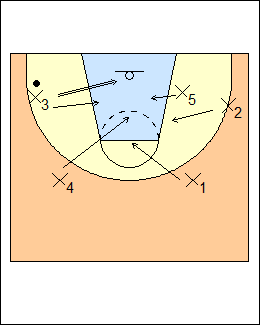 | 1 The goals of defensive transition (converting) are to protect the basket and slow down the ball. By default, all attackers crash the boards on a shot (shown), sprint back on a defensive rebound and pick up their checks. Against a fast-break team, more systematic transition defence can entail - one or more safeties who sprint back on a shot to protect the basket - picking up the ball early to slow it down - jamming the defensive rebounder, delaying an outlet pass - defending the trailer (defensive rebounder) below ball level with the jammer, providing help on the ball - covering the wing area to defend a head-man pass up the sideline. Even greater pressure can be applied by - denying an outlet pass to the point guard, slowing down the break by forcing a pass to another player - trapping on an outlet pass - trapping the defensive rebounder. Mike McNeill - if you jam the rebounder you must be able to slow the ball down once it gets out. See Defence - Defensive transition, also Transition - Lemanis 5 on 5, Woodley, Defending - Raptors 5 on 5 post entry. |
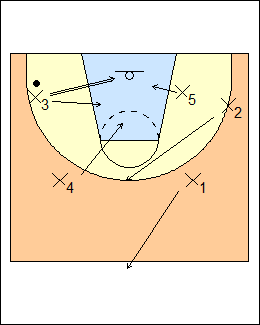 | 2 1) Man-to-man transition When team X shoots, X3, X4, and X5 crash the boards in a rebounding triangle, X1 is the long safety, getting back to halfcourt on the shot, X2 is the short safety, getting above the foul line, or above the top of the three-point line if a shooter. X2 can go for long rebounds out top. Defenders pick up their checks from these positions (X2 guards the opposing point guard), X3, X4 or X5 can jam if their check gets a defensive rebound, delaying an outlet pass, otherwise they sprint back. Variations - do not jam the defensive rebounder - X2 also gets back to halfcourt on the shot. See Sprint back (below). Mike MacKay - go to the boards if you are below the foul-line extended, otherwise get back. |
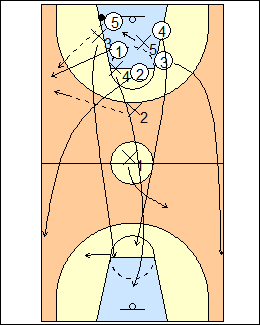 | 3 Here 5 gets the defensive rebound, so - X5 jams then matches up with 5, below ball level - X3 and X4 sprint back to build the defence, release long safety X1 to protect the basket, then find their checks - short safety X2 takes the outlet pass to 1, tries to contain the ball and keep it to the sideline - once released, X1 finds her check, here 3. If X1 can't release because of a rim run (here by 4), X4 and X3 will have to match up with remaining attackers (see match-up options, below). If 1 or 3 gets the defensive rebound, X3-X4-X5 sprint back to find their checks. |
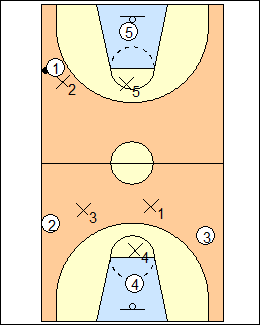 | 4 Basic fullcourt pressure, X5 defends trailer 5 at ball level, providing help on the ball. Progression - X2 denies an outlet pass to 1. Basketball Canada - deny a pass to a primary receiver (point guard), forcing an outlet pass to another player. Bob Hurley - they will deny the outlet to force the other primary ballhandler to come back to receive the ball. Andrej Lemanis - get the ball under control as early as possible, slow it down, keep it on a side and in front. |
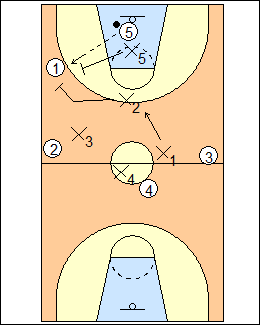 | 5 2) Trapping options Aggressive fullcourt pressure, e.g. when losing. a) Trap the outlet pass The jammer can follow the outlet pass to trap with X2, get the ball away from the point guard. Here X3 and X1 are interceptors, X4 is safety. Hoop Tactics - blitz option - as the outlet pass is released, the defender on the rebounder sprint releases (along the line of a possible return pass to the rebounder) to set a blitz trap with the on-ball defender, who turns the ballhandler into the middle. |
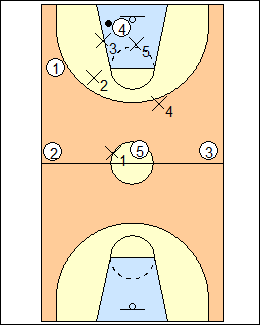 | 6 b) Trap the rebounder The two closest defenders trap the rebounder, here X3 and X5 trap 4, X2 and X4 are interceptors, X1 is safety (a 2-2-1). X2 takes away 1 (or covers ballside, or is always on the left). Can be used even if 1 or 3 gets the defensive rebound (X2 or X1's check). Doug Porter - the goal is maximum pressure at all times, the two closest defenders trap the rebounder. |
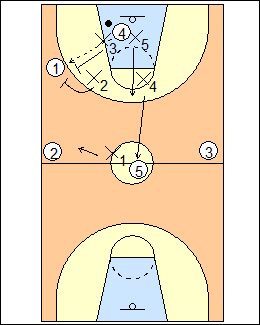 | 7 X3 or X5 can follow an outlet pass in their direction to trap, here X1 and X5 are interceptors, X4 is safety. |
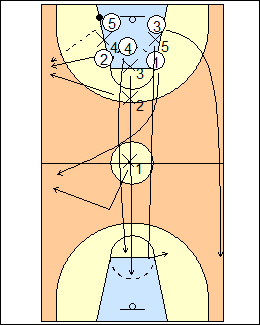 | 8 3) Match-up options Instead of trying to pick up their checks, defenders match up with attackers, X2 covers whoever gets the outlet pass. Bob Hurley - if the rebounder can put it on the floor and bust out, this will cause plenty of match-up problems. a) Jam with X3, X4 or X5 Chris Oliver - the first post back releases the "get-back" player (usually the point guard), who covers the weakside wing. See Defences - AIS defensive transition, BNSW transition, Transition - 5 on 5 defensive transition. c) Jam with X4, X1 covers ballside (shown) X4 is the jammer, the first of X3 or X5 to get back releases long safety X1, who covers the ballside sideline. |
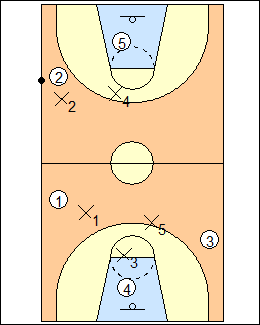 | 9 X4 defends trailer 5 at ball level, providing help on the ball. See above for trapping options. d) Guard your defender All 5 players guard the player who was guarding them when a shot goes up. Ralph Miller - use an automatic pick-up rule to control the fast break- guard the man who was guarding you when possession was lost, providing coverage on the rebound, the outlet pass, and as the offence attempts to fill the lanes. See Defence - Tagging up (all 5 players offensive rebound). Matching up can also be used to press after a made basket, see Defences - BNSW transition, Match-up press. |
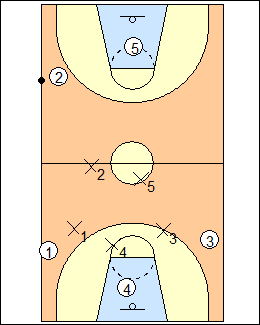 | 10 4) Sprint back Against a very good fast-break team, or when protecting a lead, make them play 5 on 5, progressions: - X3-X4-X5 all sprint back on a defensive rebound (don't jam the defensive rebounder) - X1 and X2 are both long safeties, sprinting back to halfcourt on a shot, one on each side, pick up and contain the ball at halfcourt (X2 does not take an outlet pass) - X1-X2-X3 all get back on the shot, only X4-X5 offensive rebound. Tusculum - two guards get back on the shot, remaining players sprint back. Bob Hurley - he doesn't believe in jamming the rebounder, he wants running to be instinctive. Jeff Van Gundy - send two to the glass and three back. Don Kelbick - all five guys sprint back (don't play the ball unless you have a great defender), find the ball and make sure it is covered, then find a man. Dwane Casey - on the raise of a shot, three guys get back, 3 can rebound if he is in the paint. Sprint to halfcourt, turn and point to your matchup. Don't force baseline in transition, all the help is in the middle of the floor. The second big beats his man back and gets to an elbow ready to help. Ken Shields - contain the dribbler, force sideline, establish an early strongside. (YouTube) - force left in the fullcourt. Matt Woodley - Don't pick up the ball too early, a guard stops the ball maybe around the 3-point line. The days of having a guy try to stop the ball at halfcourt are gone in his opinion. The first post guards the rim, the second post loads to the ball, helps get it under control. The rest of the guys build a wall. |
